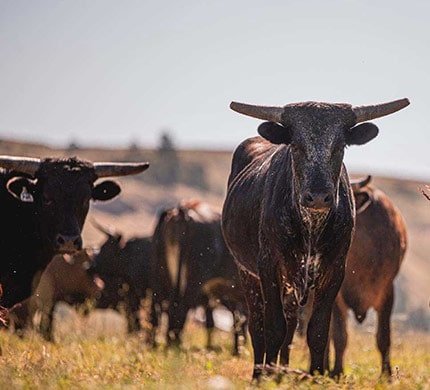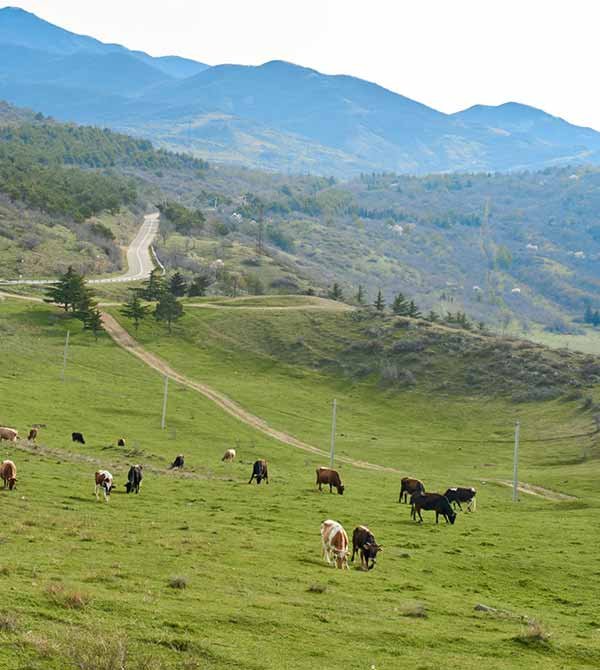Corriente
- Temperature:-10°C (14°F) to 30°C (86°F)
- Milk: 3 to 6 liters per day
- Food:Grasses, Shrubs, Hay and Silage
- Pregnancy:285 days
- Nationality:United States

General Information
Corriente cattle are a breed of cattle that are known for their agility, hardiness, and endurance. They are a relatively small breed, with mature cows weighing between 350 and 450 kg (770 to 990 lb) and mature bulls weighing between 450 and 550 kg (990 to 1210 lb). Corriente cattle are usually black or brown in color, although they can also be red or dun.
Corriente cattle were first brought to the Americas by Spanish conquistadors in the 16th century, and were used by early Spanish settlers for work, meat, and sport. They were particularly popular for their use in bullfighting and rodeo events, and continue to be used for these purposes today.
Corriente cattle are well adapted to arid and semi-arid environments, and are known for their ability to survive in harsh conditions with limited water and forage. They are also resistant to many common cattle diseases and parasites.
Where we find this cow to buy?
Corriente cattle, also known as Spanish Fighting Bull or Criollo cattle, are a breed of cattle that originated in Spain and were brought to the Americas during the 16th century. Today, Corriente cattle are primarily used for rodeo events such as team roping, calf roping, and steer wrestling, as well as for their beef.
01. Online livestock auctions : There are several online auction sites that specialize in selling livestock, including cattle. You can search these sites for Corriente cattle and bid on animals that meet your needs. Some popular online livestock auction sites include CattleUSA, DVAuction, and Superior Livestock Auction.02. Local breeders and ranches : You can also try contacting local breeders or ranches in your area that specialize in Corriente cattle. They may have animals for sale or be able to direct you to other breeders who do.03. Livestock markets and auctions : Livestock markets and auctions are another option for buying Corriente cattle. These events bring together buyers and sellers of livestock, and you can often find a variety of animals for sale.

How to increase milk production in Corriente
Corriente cattle are primarily raised for their beef, so milk production is not a major focus of their breeding. However, if you are looking to increase milk production in your Corriente cattle, there are some things you can do:
01
Make sure your cows are getting adequate nutrition and are on a well-balanced diet. Ensure they have access to clean water, and any necessary supplements.
02
Consider breeding your cows with bulls that have been selectively bred for high milk production. Talk to a Corriente cattle breeder or genetics specialist for advice on choosing the right genetics for your herd.
03
Increase the frequency of milking to stimulate milk production. Milking more frequently (up to 3-4 times per day) can help increase milk production in some cows.
04
Proper management practices, such as keeping the cows in a clean and comfortable environment, providing regular veterinary care, and avoiding stress, can also help increase milk production.
Medicine
As with all cattle, Corriente cattle may require medical treatment from time to time to maintain their health and well-being. Some common types of medicine that may be used to treat Corriente cattle include:
01
AntibioticsAntibiotics are used to treat bacterial infections in cattle, depending on the type of infection and individual needs.
02
DewormersDewormers are medications that are used to treat external parasites, such as lice and mites, in cattle.
03
VaccinesVaccines are used to prevent or reduce the severity of various diseases in cattle, including respiratory diseases, and other common cattle illnesses.
04
AnthelminticsAnthelmintics are medications used to treat internal parasites in cattle, and may need to be administered multiple times to be effective.
Pregnancy
Estrus is the stage of the reproductive cycle when the cow is receptive to mating. Corriente cows typically come into estrus every 18-24 days.
Calving usually takes place without human intervention, but it is important to monitor the cow and calf to ensure both are healthy.
After calving, it is important to provide the cow and calf with proper care and nutrition, such as monitoring milk production and providing colostrum.
Providing a balanced diet, monitoring weight gain, and providing access to clean water and shelter during pregnancy is essential for the health of the cow and calf.
Important!
Overall, the pregnancy steps of Corriente cattle are similar to those of other breeds of cattle. Proper care and management during pregnancy and after calving can help ensure the health and productivity of both the cow and the calf.
Food
Corriente cattle are adaptable and thrifty animals that can survive on a variety of diets. They are primarily foragers and grazers, and their diet mainly consists of grass and hay. However, to provide them with a well-balanced diet, it is essential to supplement their feed with other nutrients, such as protein, minerals, and vitamins.
High-quality hay, such as alfalfa and grass hay, can provide a significant portion of the cow’s diet. The hay must be fresh, clean, and free from mold or dust.
Corriente cattle thrive on a diet of fresh grass and other forage plants. Providing access to fresh pasture can significantly improve their health and productivity.
Silage is a fermented feed made from chopped grass or other crops. It is an excellent source of energy, protein, and minerals.
Corriente cattle need a variety of minerals and vitamins to maintain good health, such as salt and calcium.
Facts
Corriente cattle, also known as Mexican Corriente, are a breed of cattle that originated in Spain and were brought to the Americas during the colonial period. Here are some facts about Corriente cattle:
This cattle are popular for traditional Mexican dishes due to their lean and flavorful meat.
Hardy and adaptable to harsh environments, such as hot and arid regions.
Corriente cattle are not typically used for milk production, as they are primarily raised for meat.
Corriente cattle are small to medium-sized, with cows weighing 400-700 pounds and bulls weighing 700-1,000 pounds.
Corriente cattle are used in rodeo events such as team roping, bulldogging, and steer tripping, due to their quickness and agility.
Corriente cattle breed naturally and easily, making them a popular choice for ranchers who prefer not to use artificial insemination.
Corriente cattle are well-suited to grazing on open rangeland, as they are foragers and can survive on grass and other vegetation.